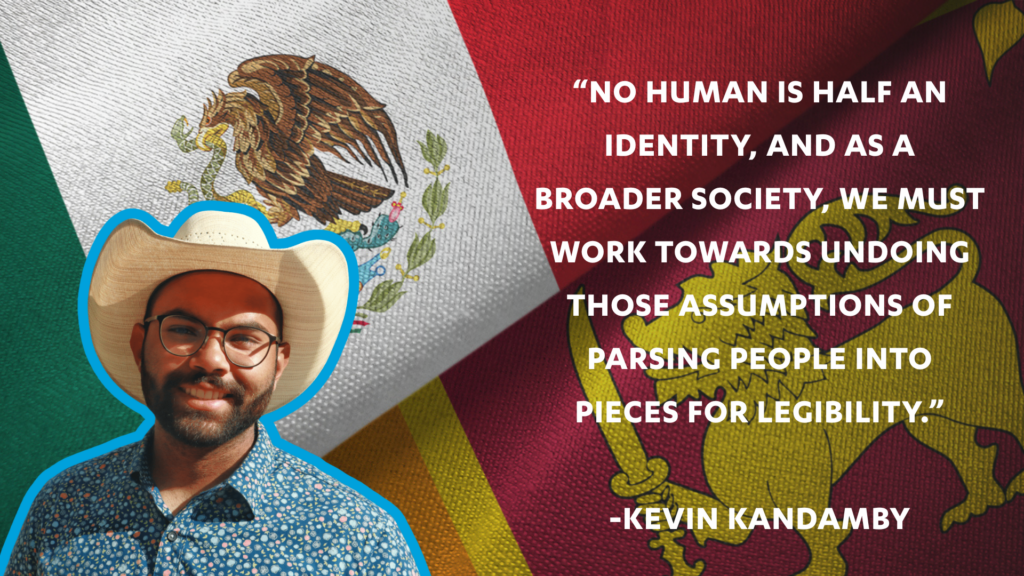Charlita: Kevin Kandamby on the AAPI Latino Experience and Its Growing Impact

The United States’ diverse population includes a vibrant and growing AAPI Latino community, yet their unique experiences and identities remain underrepresented in research and policy discussions. We had a Q&A with Kevin Kandamby, a Ph.D. student at UCLA and co-author of our AAPI Latinos brief, released last year, which sheds light on the diversity and growth of this demographic. In this conversation, Kevin reflects on the brief’s positive reception, the personal inspiration behind his research as a MexiLankan scholar, and the critical need for intersectional data and dedicated community spaces to support AAPI Latinos in areas like education, language access, and economic opportunity.
Q: Your report about AAPI Latinos in the United States was released a year ago. Can you give us your impression of the reception?
Kevin: I believe the report has been received positively. The attention received has spanned across social media, news outlets, and academic spaces. The difference that I have noted is that those unfamiliar with the AAPI Latino demographic are now paying closer attention to this growing demographic, such as monoracial/monoethnic Latino and Asian American media outlets. For those who identify as AAPI Latino, they have expressed that they feel seen and relate to other AAPI Latinos who have engaged with the AAPI Latino report.
The positive reception is a breath of fresh air. While I am certainly not the first to write about the experiences of the growing AAPI Latino community, I stand on the shoulders of various scholars who for so long have been urged society to focus on how the multiracial demographic in the United States is growing and how minority communities are shaping the growth.
Q: What inspired you to explore the intersection of AAPI and Latino identities in this way?
Kevin: I am MexiLankan, a child of immigrants from México and Sri Lanka. This experience, although unique to me, is not one that I am unfamiliar with. As a first-generation college student taking classes in ethnic studies, I always felt as if my experience as a mixed child of immigrants was never fully represented in my Chicano/Latino studies and Asian American studies courses, yet so much of those experiences overlapped all the time. During my second year in undergrad, I was introduced to research by Rudy Guevarra Jr., Karen Leonard, and Robert Chao Romero on Mexipinos, Punjabi Mexicans, and Chinese Mexicans that sparked a deep interest on the AAPI Latino and Asian diasporas across Latin America.
In my third year at Pitzer College, I was fortunate to become a Mellon Mays Undergraduate Fellow, where I could pursue my research interests in AAPI Latino experiences in the United States. Since then, I have continued to dedicate my research interests to the growing AAPI Latino demographic and our identity formation processes here in the United States at UCLA in the Chicana/o and Central American Studies department Ph.D. program. Ultimately, I am inspired to explore AAPI Latino identities so that other AAPI Latinos like my niece and nephew can one day pick up a book and see themselves and their family histories represented in both the AAPI and Latino communities.
Q: One of the key findings of the report is the diversity and growth of the AAPI Latino population. What do you think is still missing in the broader public or policy conversation about this community?
Kevin: There is still so much to learn about the AAPI Latino population. One thing for certain is that the community is flourishing, and in various directions like the rhizome of a plant. The AAPI Latino cannot be homogenized into one experience and must be recognized as AAPI, Latino, and AAPI Latino. We belong to these communities and must be recognized as a whole, not half AAPI and half Latino. No human is half an identity, and as a broader society, we must work towards undoing those assumptions of parsing people into pieces for legibility.
Q: How can researchers and policymakers better support AAPI Latinos, especially in areas like language access, education, or economic opportunity?
Kevin: Researchers and policymakers can create more opportunities for AAPI Latinos to come together and create a community. Although many AAPI Latinos live in neighborhoods with large AAPI and Latino populations, these areas do not automatically provide dedicated spaces for AAPI Latinos to build community.
Q: As we reflect on AAPI Heritage Month, why is it important to continue investing in disaggregated data and intersectional research like this?
Kevin: Investing in disaggregated data and intersectional research enriches our understanding of the diversity within the AAPI and Latino demographic. The needs of each community are contextual, and having more specific data available allows for those who are often homogenized into broader understandings of AAPI identity or Latino identity to be represented and advocated for. Intersectional research strengthens and deepens the needs for our communities without overlooking one community’s needs over another, as disaggregated data provides a more enriching understanding to contextualize how researchers and policymakers can best support the AAPI Latino community.








